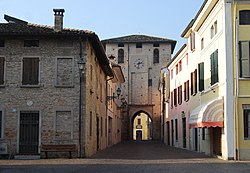| Ceresara | ||
 | ||
| Salutation | Sareşére (in Mantuan dialect) | |
|---|---|---|
| State | Italy | |
| Region | Lombardy | |
| Territory | Alto Mantovano | |
| Altitude | 44 m a.s.l. | |
| Inhabitants | 2.622 (estimate / 2017) | |
| Name inhabitants | ceresaresi | |
| Prefix tel | 39 0376 | |
| POSTAL CODE | 46040 | |
| Time zone | UTC 1 | |
| Patron | San Biagio | |
Position
| ||
| Institutional website | ||
Ceresara is a city of Lombardy.
To know
The town is located in the Middle-Alto Mantovano and precisely on the plateau between Mincio and Oglio.
How to orient yourself
How to get

Church of SS. Trinity
By plane
![]() The nearest airports are:
The nearest airports are:
- 1 Bergamo-Orio al Serio Airport (the Caravaggio), Via Aeroporto 13, Orio al Serio, ☎ 39 035 326323.
- 2 Brescia-Montichiari Airport (Gabriele D'Annunzio), Via Aeroporto, 34, Montichiari (BS), ☎ 39 030 9656599, fax: 39 030 9656514. Charter only
- 3 Verona-Villafranca Airport (Valerio Catullo), Boxes of Sommacampagna (VR), ☎ 39 045 8095666, fax: 39 045 8619074.
By car
Highways
The closest motorway exits are:
 Brenner motorway: exit Mantua north, then direction Gazoldo degli Ippoliti, Rodigo and Ceresara
Brenner motorway: exit Mantua north, then direction Gazoldo degli Ippoliti, Rodigo and Ceresara Serenissima motorway: exit Desenzano del Garda, then direction Castiglione delle Stiviere, Medole and Ceresara
Serenissima motorway: exit Desenzano del Garda, then direction Castiglione delle Stiviere, Medole and Ceresara
On the train
![]() The nearest stations are:
The nearest stations are:
- 4 Mantua railway station, Don Leoni square. On the director Verona-Modena.
By bus
Service carried out by APAM.
How to get around
What see

Sanctuary of the Possenta
- 1 Sanctuary of the Beata Vergine della Possenta, Possenta hamlet. Built in a rural location between the fourteenth and fifteenth centuries with a single nave with barrel arch and with a façade in Baroque style, it is dedicated to the Annunciation.
- 2 Church of the Holy Trinity. Perhaps dating back to the 12th century.
- 3 Civic tower. Dating back to the 13th century.
- 4 Palazzo Secco-Pastore, Fraction San Martino Gusnago. From the 15th century.
- 5 Basalgana Court, Villa Cappella hamlet.
Events and parties

Palazzo Secco-Pastore
- Fair of the Possenta (At the end of March). It takes its name from the small Sanctuary of the Beata Vergine della Possenta on the border with the territory of Goito. The origins date back to 1870.
- Festa de la Saresa (In June). The event includes numerous food and wine events and music and dance shows and themed conferences.
- 5 Convivium at the Palace, Palazzo Secco-Pastore - San Martino Gusnago hamlet (In June). Historical re-enactment of a Renaissance banquet-
What to do
Shopping
How to have fun
Where to eat
Local specialties: Tortello della Possenta, Ceresarese family salami, Dolceresa cake, Ceresara cherry].
Average prices
- 1 Loghino Bel Sito, Via Villa Belgiardino 8 - Villa Cappella, ☎ 39 335 5225800.
Where stay
Safety
How to keep in touch
Around
- San Martino Gusnago
- Castel Goffredo - The industrialized "city of the sock" of modern times has a past as a Gonzaga capital which has endowed it with an important historic center; the squares, the arcades, the churches, the palaces permeate it with the unmistakable atmosphere that characterizes the urban planning of the Gonzagas.
- Castiglione delle Stiviere - City of the Red Cross and of San Luigi Gonzaga, protagonist in the wars of the Risorgimento, it was a Gonzaga center; it retains a beautiful historic core that extends over the morainic hills south of Lake Garda. After the war it experienced a strong economic expansion that favored an important demographic growth, making it the reference center of theAlto Mantovano.
- Alto Mantovano - Borderland of the Duchy of Mantua, which pursued the dream of obtaining an outlet on Lake Garda without ever realizing it, developed the courts of cadet branches of the Gonzaga family. Castel Goffredo, Castiglione delle Stiviere, Carpenedolo retain the urban layout and monuments of that era. The post-war period saw good employment development, with a consequent increase in well-being and population.
- Mantua - Capital of the Gonzagas, it still emanates its subtle charm of a great city of art for which it appoints it a UNESCO World Heritage Site it was not so much a recognition as a necessary acknowledgment. Its ancient atmospheres are incomparable, the profiles of the palaces and domes that stand out in the Po Valley mist enveloped by the mirror of its lakes, its endless Gonzaga palace that incorporates numerous buildings in the city center.
Itineraries

Morainic hills
- Via Postumia - It retraces the ancient Roman itinerary that connected Genoa to Aquileia, touching many municipia and city of the empire.
- In the lands of the Gonzagas - An itinerary through the centers, large and small, which were the capitals of the Gonzaga cadet branches: principalities, marquisates, duchies which, within the Mantuan state structure, enjoyed real independence, often minted coins and held refined courts that rivaled that of Mantua, embellished their urban centers by equipping them with elegant architecture - churches, squares, palaces, walls, towers - and characteristic urban views such as the typical Gonzaga arcades.
- Places of the battle of Solferino and San Martino - The itinerary runs through the places where the historic one took place on 24 June 1859 battle of Solferino and San Martino.
- Rural churches and oratories of Castel Goffredo - The itinerary, entirely in the green countryside rich in waterways, runs through the numerous places of worship, which boast ancient traditions and are the sign of a widespread religiosity, since the sixteenth century.
- Towers and castles of the Alto Mantovano - The route touches places and villages that preserve towers, castles, fortifications built by the powerful Canossa, Scaligeri, Visconti and Gonzaga families.

